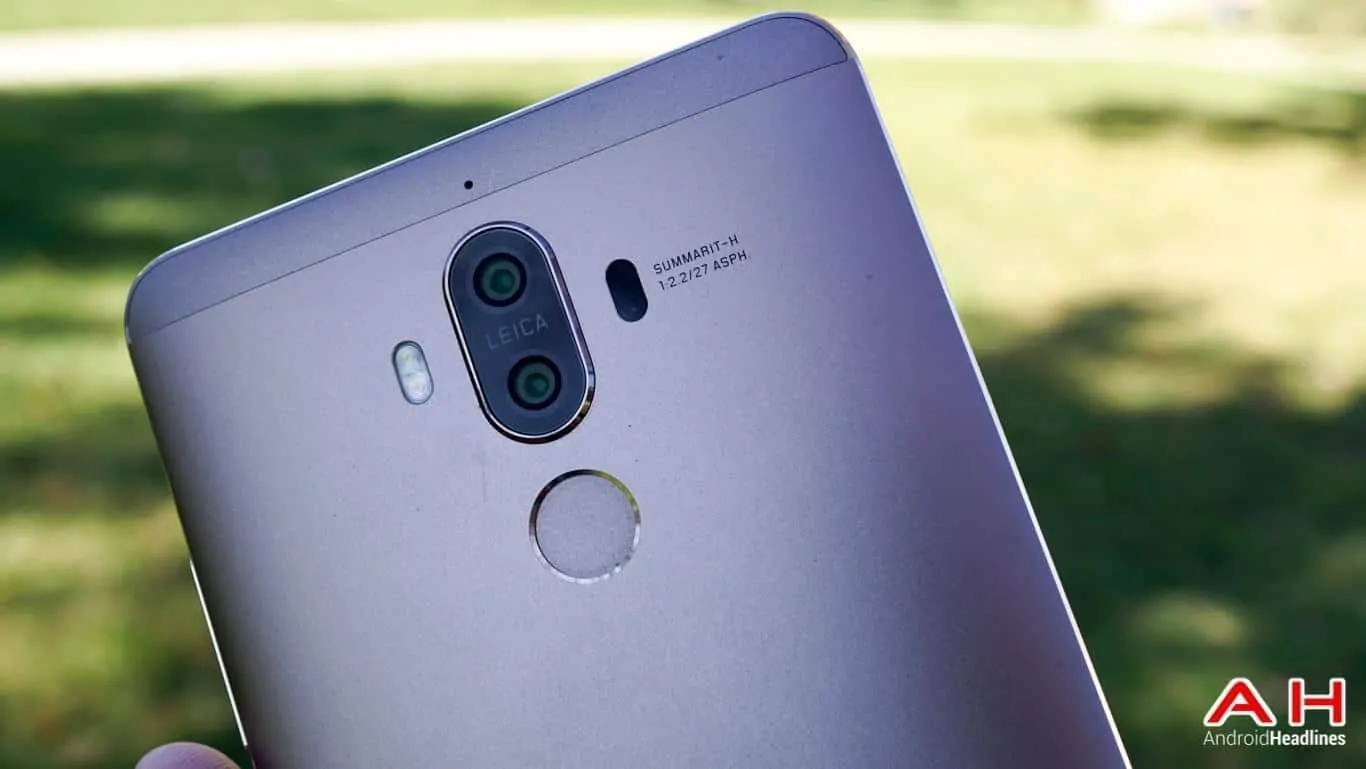Introduction
Do we have a good one for you today – The Google Pixel takes on the newest Huawei Mate 9. The Pixel name is Google’s replacement for their Nexus line of phones and a piece of the Google ecosystem. It is the first phone to have Google Assistant built-in and comes to us with a polished glass and metal backing. The Mate 9 is an all-metal device with the general Huawei look with small bezels, curved sides and back making it comfortable to hold. Both devices are high quality, and are well-built. Let’s look at just what these two devices have in common, if anything, and then we will take a closer look at each one in hopes that we can determine a winner of this comparison.
The Google Pixel and the Huawei Mate 9 have very little in common. The display on the Mate 9 is 0.9-inches larger, so the physical size and weight are entirely different. The displays use a different technology, but they do use the same Full HD resolution. They both use a different processor and GPU, although in the same league, and they both pack 4GB of DDR4 RAM. The primary camera areas could not be more different – the Pixel uses one 12.3MP sensor, and the Mate 9 uses a 20MP and 12MP sensors – but both produce excellent photos. They both have an 8MP front-facing camera (FFC) for selfies and video chatting. Both have a fingerprint sensor for unlocking your device as well as authorizing mobile payments. They both use a non-removable battery, although the Mate 9’s is much larger, and both have rapid charge capabilities. They come with the usual suspects – WiFi, Bluetooth v4.2, GPS, NFC, and the newer Type-C reversible port for charging and data transfer.
Please take a thoughtful look at the detailed Specifications Comparison chart below and here you will see just how these two great devices stack up against one another – click on the “View Full Comparison” link at the end of the chart to expand the details. After that, we will look at each device in greater depth and point out some of its pros and cons. From all of this information, we will try to determine the winner based on specs and execution of design and functions.
Specifications
Google Pixel
![]() Google is seeking to have more control over the building of hardware and software together, which should allow Google to get their ecosystem going faster. You can use your Google Pixel phone that has Google Assistant built-in to send orders to your Google Home, and then Home can execute your instructions. IoT (Internet of Things) is taking off in our homes, and Google Assistant will eventually work with them. The new Pixel devices incorporate polished glass and metal as their backing and offer a great feel in your hand. Let’s see how this newly designed Pixel with its polished glass and metal construction holds up to the Huawei Mate 9.
Google is seeking to have more control over the building of hardware and software together, which should allow Google to get their ecosystem going faster. You can use your Google Pixel phone that has Google Assistant built-in to send orders to your Google Home, and then Home can execute your instructions. IoT (Internet of Things) is taking off in our homes, and Google Assistant will eventually work with them. The new Pixel devices incorporate polished glass and metal as their backing and offer a great feel in your hand. Let’s see how this newly designed Pixel with its polished glass and metal construction holds up to the Huawei Mate 9.
The Google Pixel sports a 5.0-inch AMOLED display with a Full HD resolution of 1920 x 1080 pixels and a respectable 441 pixels-per-inch (PPI) mostly due to the size of the screen. While it is only an FHD display (just like the Mate 9), it is an AMOLED display should help make it ‘pop’ with contrasts and colors. It is using the newest 64-bit Qualcomm Snapdragon 821 quad-core processor, which is a revised example of the Snapdragon v820 and according to Qualcomm; it gives a 10-percent performance boost over the original v820. It comes with a dual-core clocked at 1.6GHZ and a dual-core clocked at 2.15GHz and uses an Adreno 530 for serious graphic needs. It packs 4GB of DDR4 RAM and either 32GB or 128GB of the faster UFS 2.0 memory with no means to expand. It uses a 2770mAh non-removable battery for power and has rapid charge capabilities.
Nexus smartphones always had dubious cameras at best until things turned around with the Nexus 6, continued on the Nexus 6P, and their commitment to quality really shows on their Pixel models. The specs do not seem that impressive with a 12.3MP sensor for their primary camera, an aperture of f/2.0, phase detection autofocus (PDAF), and laser autofocus, a dual-tone LED flash, and no OIS. However, when DxOMark tested the Pixel camera, it received a score of 89 – the highest sustained for a smartphone camera to date. There is an excellent 8MP front-facing camera (FFC) that comes with a f/2.0 aperture, a 1.4µm pixel size, and 1080p recording. This combination should offer great selfies and video chatting.
The looks of the Pixel’s polished glass and metal backing are still under debate by some, but this writer thinks it looks just fine. It is on the back of the Pixel where you will find a rear-mounted fingerprint sensor that will allow you to unlock your device or authorize mobile payments, including Android Pay. The Pixel does have at least an IP53 certification rating for splash and dust resistance. The Pixel comes running Android 7.1 Nougat out of the box and will continue to receive the fastest updates from Google. The Google Pixel measures in at 143.8 x 69.5 x 8.5mm and weighs in at 143 grams. It comes in Quite Black, Very Silver, and Really Blue (limited edition color) and the 32GB Google Pixel will cost you about $650.
Huawei Mate 9
 Huawei likes big screen devices, and this is where the Mate series comes into play. The Huawei Mate 9 is the newest in this lineup of larger smartphones. Although it has a large 5.9-inch display, Huawei was able to keep the Mate 9 relatively compact in physical size with its small bezels. There is a US version on its way, but for now, it will only work on GSM networks, leaving Verizon and Sprint subscribers out in the cold. The Mate 9 only comes with a Full HD LCD display resolution – a screen this large could actually use a higher resolution, but Huawei believes they are unnecessary. It has a solid build to it and with its slightly curved edges feels great to hold over an extended period. Let’s see just how it stacks up to the Google Pixel.
Huawei likes big screen devices, and this is where the Mate series comes into play. The Huawei Mate 9 is the newest in this lineup of larger smartphones. Although it has a large 5.9-inch display, Huawei was able to keep the Mate 9 relatively compact in physical size with its small bezels. There is a US version on its way, but for now, it will only work on GSM networks, leaving Verizon and Sprint subscribers out in the cold. The Mate 9 only comes with a Full HD LCD display resolution – a screen this large could actually use a higher resolution, but Huawei believes they are unnecessary. It has a solid build to it and with its slightly curved edges feels great to hold over an extended period. Let’s see just how it stacks up to the Google Pixel.
The Huawei Mate 9 sports a large 5.9-inch IPS LCD FHD display with a resolution of 1920 x 1080 pixels and only 373 PPI due to its large size. It is so large, the Mate 9 takes the term phablet to a new height. It does run Android 7.0 Nougat out of the box on a powerful 64-bit Hisilicon Kirin 960 octa-core processor with four cores running at 1.8GHz and four cores running at 2.4GHz. It packs 4GB of RAM and 64GB of expandable internal memory, and for graphics, a Mail-G71 MP8 GPU provides outstanding performance.
Huawei spared no expense in the camera area by using dual Leica optics – a 20MP sensor for colored photos and a 12MP sensor that shoots strictly monochrome (B&W) photos. Then they added an aperture of f/2.2, OIS, 2X zoom, with both Phase Detection Autofocus (FDAF) and laser autofocus, with a dual-tone LED flash. This combination gives photographers the ability to experiment with some great B&W shots. For the FFC the Mate 9 uses a large 8MP sensor with a f/1.9 aperture and 26mm wide-angle lens for great selfies and video chatting. The Mate 9 has a large, non-removable 4000mAh battery with Huawei’s own SuperCharge that will charge your battery from 0-100-percent in only 90 minutes with the provided charger.
The Mate 9 is a big and beautiful smartphone with many good qualities, but like any smartphone, there are disappointments. We have a large display, but only a Full HD resolution of 1080p. It does have stereo speakers with one set on the bottom of the phone, and the second speaker is the earpiece, and they put out some nice sounds. If you place headphones in the 3.5mm jack, they sound good as well. It is also disappointing in a device this expensive there is no dust or water protection. Like the Pixel, the Mate 9 has a rear-facing fingerprint sensor to unlock the device or authorize mobile payments. The Mate 9 is running Android 7.0 Nougat out of the box and measures 156.9 x 78.9 x 7.9mm, weighs in at 190 grams and comes in Space Gray, Moonlight Silver, Champagne Gold, Mocha Brown, Ceramic White, and Black. Its pricing should be somewhere in the $750 range.
…And The Winner Is…

The Final Word
This is a tough decision to make – on the one hand, we have the Google Pixel that costs less and has a much smaller display. One the other hand, the excellent Huawei Mate 9 that is a photographer’s dream. It is true that right now the Mate 9 will only work on AT&T and T-Mobile, but with the promise of a US version to cover all networks, it could be a great decision.
Okay, I am going to bite the bullet and chose the Huawei Mate 9 as the winner of this comparison. It has a larger display, but not so bulky you can’t pocket the device. It has a very powerful processor and GPU, and expandable memory. It comes with stereo speakers that offer great sound, and the Leica dual lenses and camera software are just what a photo bug loves. It has wonderful battery life and SuperCharge and using the included charger, and it can output up to 4.5A. It also sports an IR Blaster, is running Android 7.0 Nougat, and it is a well-built and beautiful looking device.
The Google Pixel phone is a nice device, and yes, it will get the fastest software updates each year and it does run Google Assistant. It has a great camera with fewer options. However, it all seems a little dull when compared to the Mate 9.
[socialpoll id=”2404368″]

